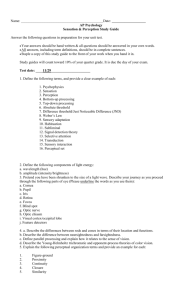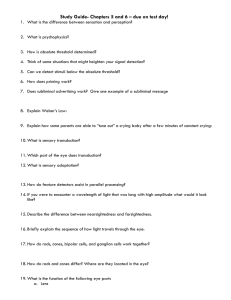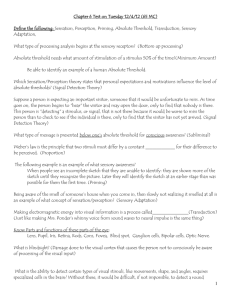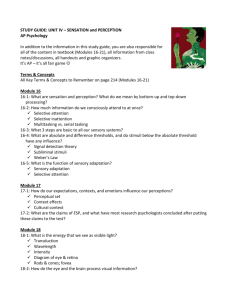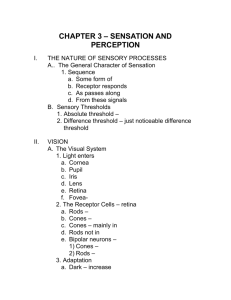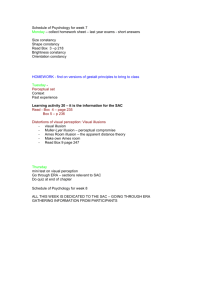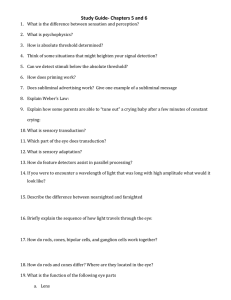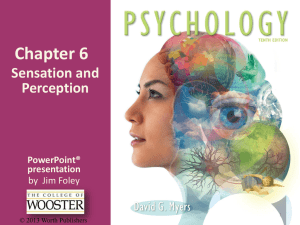Reading Guide: Sensation & Perception
advertisement
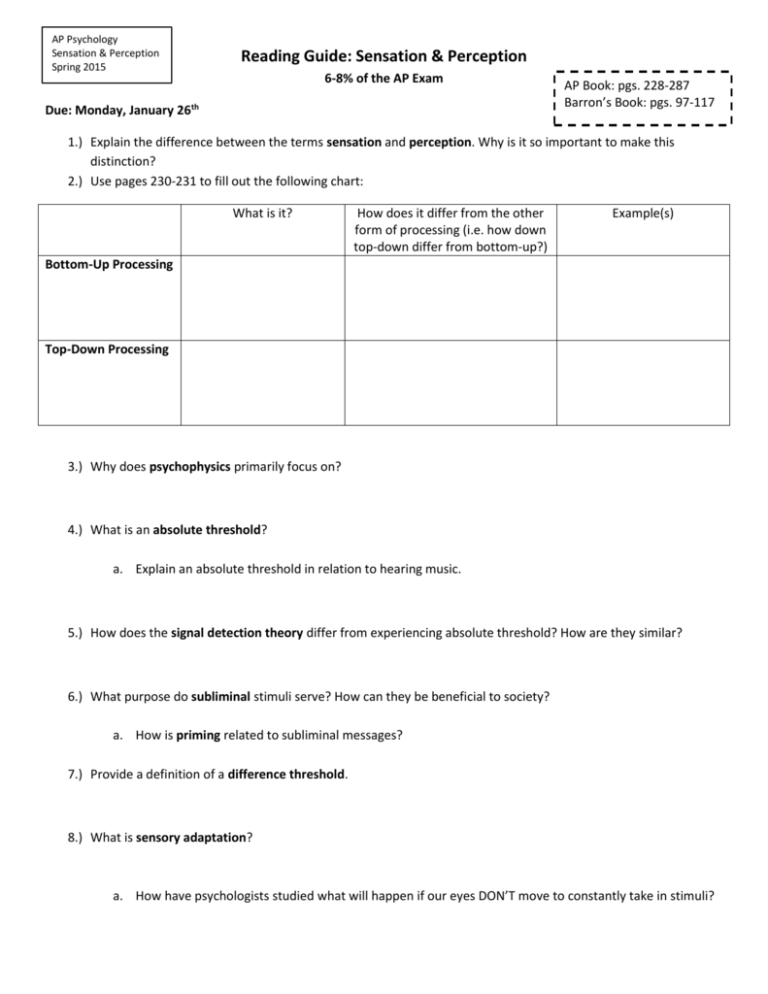
AP Psychology Sensation & Perception Spring 2015 Reading Guide: Sensation & Perception 6-8% of the AP Exam Due: Monday, January 26th AP Book: pgs. 228-287 Barron’s Book: pgs. 97-117 1.) Explain the difference between the terms sensation and perception. Why is it so important to make this distinction? 2.) Use pages 230-231 to fill out the following chart: What is it? How does it differ from the other form of processing (i.e. how down top-down differ from bottom-up?) Example(s) Bottom-Up Processing Top-Down Processing 3.) Why does psychophysics primarily focus on? 4.) What is an absolute threshold? a. Explain an absolute threshold in relation to hearing music. 5.) How does the signal detection theory differ from experiencing absolute threshold? How are they similar? 6.) What purpose do subliminal stimuli serve? How can they be beneficial to society? a. How is priming related to subliminal messages? 7.) Provide a definition of a difference threshold. 8.) What is sensory adaptation? a. How have psychologists studied what will happen if our eyes DON’T move to constantly take in stimuli? 9.) What two physical characteristics of light determine our sensory experience? 10.) Use pages 237-239 to fill in the following chart: Location within the eye Function within the eye (What does it do?) Pupil Iris Lens Retina Rods & Cones Optic Nerve Fovea 11.) Explain how a blind spot develops within one’s visual field 12.) What do feature detectors do within the brain? 13.) What is one example of a task a feature detector can accomplish? 14.) Why is parallel processing (the ability to do many thing at once) so imperative to perceiving any situation or setting? 15.) What is the rapid sequence of events that occurs when you see and recognize someone you know? 16.) Explain how someone experiences color according to the Young-Helmholtz trichromatic theory. 17.) For most people, what does it actually mean to be “colorblind?” 18.) What does the opponent-process theory have to do with afterimages? 19.) When it comes to audition (or the ability to hear), how do pitch and frequency relate? 20.) Using pages 246-248, complete the following chart: What structure(s) comprise this part of the ear? How does this part of the ear enable us to hear? Outer Ear Middle Ear Inner Ear 21.) Provide an explanation of Hermann von Helmholtz’s (debatably the coolest name in psychology history) place theory. 22.) Since the place theory cannot explain how we experience low pitches, the frequency theory is necessary to understand. How does it help us experience low pitches? 23.) Provide two benefits to having two ears on either side of head compared to one large ear in the middle of our face. 24.) What are two benefits of using a cochlear implant to restore hearing to due to sensorineural hearing loss? 25.) What is kinesthesis? 26.) What is your vestibular sense? How does it differ from kinesthesis? 27.) Use pages 252-255 to complete the following chart about pain: How does this perspective explain the origin of pain? Example(s) Biological influences on pain Gate Control Theory: Psychological influences on pain Social-Cultural influences on pain 28.) What are the five different major taste receptors humans experience? 29.) Provide a definition of sensory interaction. What does this have to do with the color of our food? 30.) Explain how olfaction (experiencing smell) is a chemical reaction. 31.) How does experience relate to smell preference? 32.) Use pages 263-265 to explain gestalt (grouping) principles How does principle help us understand “wholeness”? Figure-ground Proximity Example (Can draw an example if necessary!) Similarity Continuity Connectedness Closure 33.) How does the visual cliff help infants experience depth perception, or seeing objects in three dimensions? 34.) What is the difference between a binocular depth cue and monocular depth cue? a. Provide and describe an example of a binocular depth cue b. Provide and describe an example of a monocular depth cue 35.) How does the phi phenomenon relate to seeing motion? 36.) Use pages 269-272 to complete the following chart How does this help us organize and understand perceptions? Perceptual constancy Shape constancy Size constancy Lightness constancy Color constancy Example(s) 37.) Explain what perceptual adaptation is and how it relates to wearing upside-down glasses. 38.) How do perceptual sets (or a mental predisposition to see one thing compared to another) lead to misunderstandings within society? 39.) What role does context play in perceiving one’s surroundings? Provide an example of how this works. 40.) What do human factors psychologists do to help everyone perceive the world easier? 41.) Provide a definition of ESP (extrasensory perception). a. Based on the claims made on pages 282 and 283, do you believe ESP is real? 42.) Provide two examples of experiments conducted to test the validity of ESP.


